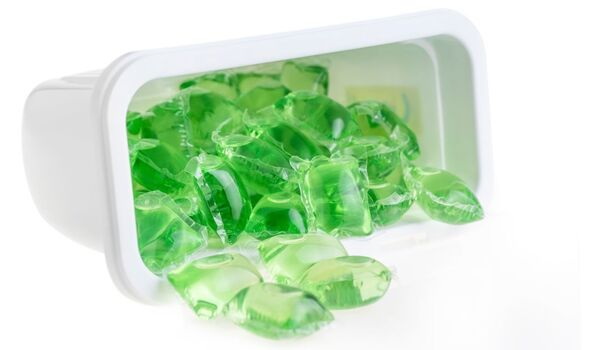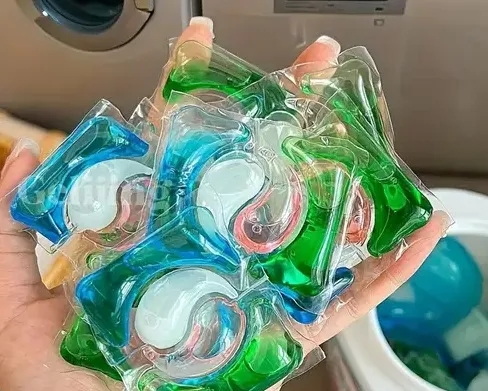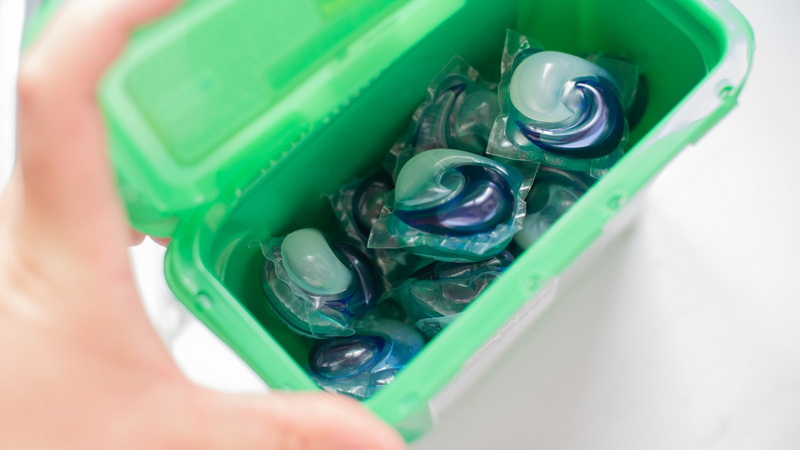Dongguan UFine Daily Chemical Co.,Ltd.
- All
- Product Name
- Product Keyword
- Product Model
- Product Summary
- Product Description
- Multi Field Search
Views: 222 Author: Tomorrow Publish Time: 11-17-2025 Origin: Site











Content Menu
● What Are Laundry Pods Made Of?
● How Does PVA Film Behave in Water?
● Are Laundry Pods Recyclable?
● Environmental Impact of Laundry Pods
>> Microplastic and Chemical Concerns
>> Energy and Carbon Footprint
● Comparing Laundry Pods to Traditional Detergents
● Efforts by Manufacturers for Sustainability
● The Role of Consumers in Responsible Use
● Are Laundry Pods Compostable?
● The Broader Sustainability Context
● Technological Innovation and the Future of Laundry
● The Misconception of “Recyclable” in Marketing
● Practical Tips for Eco-Friendly Laundry
● Moving Toward Circular Laundry Systems
● FAQ
>> (1) Are laundry pods recyclable in domestic recycling systems?
>> (2) Are laundry pods biodegradable?
>> (3) Are there eco-friendly alternatives to laundry pods?
>> (4) How should empty laundry pod containers be handled?
>> (5) What changes can consumers make to reduce laundry's environmental impact?
Laundry pods have transformed modern washing routines with their simplicity and efficiency. These small, pre-measured capsules eliminate the need for scooping or pouring detergent, minimizing spills and ensuring consistent cleaning results. However, as sustainability gains global attention, many consumers are asking: Is a laundry pod recyclable?
Understanding the recyclability of laundry pods requires exploring what they are made of, how they interact with water and the environment, and what sustainable choices are available to consumers and manufacturers today.

A laundry pod typically combines two components:
1. Concentrated detergent mixture. This liquid or gel blend contains surfactants, enzymes, stain removers, and brightening agents designed to deep-clean fabrics.
2. Outer water-soluble film. This film is usually composed of polyvinyl alcohol (PVA or PVOH), a synthetic polymer that dissolves when exposed to water.
This dual design offers remarkable convenience—each pod delivers the perfect detergent dose while eliminating plastic bottles. Yet, this innovation comes at an environmental cost when considering recyclability and biodegradability.
Unlike PET bottles or HDPE jugs that can be collected and reprocessed, PVA film dissolves during washing, meaning it does not pass through traditional recycling systems. Understanding this difference is critical when evaluating the product's environmental footprint.
When placed in a washing machine, the laundry pod's PVA film dissolves as water agitates it. Though the film appears to vanish, it does not simply evaporate—it disperses into small organic molecules and microscopic plastic residues that end up in wastewater.
Under ideal conditions, wastewater treatment plants can break down a significant portion of PVA through biological degradation. However, not all facilities are capable of fully removing it. The extent of breakdown depends on microbial availability, oxygen concentration, and water temperature. Some studies suggest that up to 25–35% of dissolved PVA may bypass treatment and enter rivers or oceans, potentially joining other microplastic contaminants.
This incomplete degradation process has raised questions about whether laundry pods are as eco-friendly as promoted.
The short answer is no. Laundry pods themselves are not recyclable through any curbside or municipal recycling program. The PVA film is designed for single use and dissolution, not recovery or reuse. Its chemical structure limits the ability to turn it back into new materials.
However, some packaging associated with laundry pods is recyclable. For example:
- Plastic tubs used by brands like Tide, Persil, and Gain are typically made of high-density polyethylene (HDPE) or polypropylene (PP), both of which can be recycled if cleaned and properly sorted.
- Cardboard boxes used in eco-brand packaging can enter paper recycling streams, depending on any added coatings or linings.
In short, while the pod films are not recyclable, the external packaging can be, and consumers can make a small difference by disposing of it properly.
Many consumers assume dissolving means disappearing without harm, but environmental science tells a more complex story. While dissolving prevents visible litter, the resulting substances remain in wastewater systems.
PVA is classified as a synthetic polymer, and partial degradation can release microscopic fragments. These residues may contribute to microplastic pollution, one of the fastest-growing environmental issues worldwide. Even if they are not classified as hazardous plastics, they can absorb other pollutants, interfere with aquatic life, and persist in ecosystems.
Additionally, other ingredients found in laundry pods—such as optical brighteners, dye fixatives, and surfactants—can strain wastewater treatment systems. Although regulated by environmental agencies, they still contribute to chemical loads entering water bodies.
Producing PVA films and concentrated detergents involves petrochemical feedstocks and energy-intensive processes. The carbon footprint from manufacturing, packaging, and transport of pods can be higher than bulk liquid detergent if scaled across billions of uses.
However, pods have efficiencies in dosing and transport weight that partially offset this footprint, especially when compared to over-poured liquid detergents or heavy packaging waste.
| Type of Detergent | Packaging Material | Recyclable | Environmental Impact | Convenience Level |
|---|---|---|---|---|
| Liquid detergent | Plastic bottle (HDPE) | Yes | Moderate | Moderate |
| Powder detergent | Cardboard box | Mostly | Lower | Moderate |
| Laundry pod | PVA film + plastic tub | Partially (tub only) | Potential PVA residue | Very high |
| Detergent sheet | Paper or compostable film | Often yes | Low | High |
From this comparison, laundry pods stand out for convenience but lag behind in recyclability. The growing interest in detergent sheets shows that consumers increasingly seek sustainable yet simple cleaning options.

Several detergent manufacturers are exploring new solutions to address laundry pod sustainability challenges. Initiatives include:
- Material redesign. Research teams are experimenting with biodegradable biopolymers derived from plants, starches, or cellulose that can decompose naturally after dissolving.
- Reduced packaging waste. Companies now offer refill packs to minimize single-use plastic tubs.
- Renewable energy manufacturing. Some producers aim to offset emissions by powering factories with solar or wind energy.
- Wastewater compatibility testing. Several research projects evaluate how different PVA chemistries interact with wastewater microbes under real operating conditions.
While the industry acknowledges that current pods are not yet recyclable, such efforts mark meaningful steps toward a circular cleaning economy.
Sustainability does not depend solely on manufacturers. Every household plays a role in responsible consumption. Here are some actions consumers can take:
1. Recycle the outer packaging. Check for recycling symbols and rinse containers before disposal.
2. Store pods properly. Prevent waste by keeping them sealed and away from humidity.
3. Use only when necessary. Running smaller or half-load cycles wastes detergent and water.
4. Avoid excessive temperature use. Cold-water washing reduces energy and carbon footprint.
5. Opt for eco-certified brands. Look for transparent brands with biodegradable claims verified by authorities such as the EPA Safer Choice label.
Even modest behavior changes at scale can generate significant environmental benefits.
Another common question is whether the PVA film can be composted. Unfortunately, it cannot. Since PVA is synthetic, it does not decompose into nutrient-rich organic matter required by compost systems. Attempting to compost PVA-based pods could contaminate the process and disrupt microbial balance.
However, innovators are experimenting with fully compostable pod alternatives using bio-based polymers. These starch or cellulose-derived materials aim to achieve industrial composting compatibility, offering the convenience of pods without plastic persistence.
Addressing laundry pod recyclability is part of a larger discussion about sustainable consumer behavior and corporate responsibility. A truly eco-friendly laundry product should meet the following conditions:
- Minimal plastic use.
- Full biodegradability or recyclability of packaging.
- Non-toxic ingredients safe for wastewater systems.
- Efficient cleaning power at low temperatures.
Future environmental regulations may push detergent companies to rethink their formulas and packaging, ensuring compatibility with circular economy principles.
Science and technology are rapidly responding to sustainability demands. Several exciting solutions are emerging:
- Algae-based films that dissolve and biodegrade in both marine and soil environments.
- Zero-water detergent concentrates that reduce packaging volumes and emissions.
- Reusable detergent containers with refill stations in supermarkets.
- Smart washing machines that use smaller amounts of detergent per load.
These innovations could ultimately replace traditional pods and plastic bottles, turning laundry into a near-zero-waste process.
Many consumers misunderstand environmental labels. A product marketed as “eco-friendly” does not automatically mean recyclable or biodegradable. The detergent industry has occasionally been criticized for “greenwashing”—using terms that sound sustainable but lack scientific backing.
True recyclability requires the material to be collected, processed, and transformed into new products—conditions that water-soluble PVA films cannot meet. Therefore, calling pods recyclable is misleading. Better consumer education and transparent labeling are necessary to ensure informed choices.
If switching away from pods entirely is not an option, here are small yet effective steps to improve sustainability:
- Choose detergents sold in cardboard boxes or refill pouches instead of rigid tubs.
- Skip the dryer when possible—air drying saves up to 5% of household energy use.
- Avoid fabric softeners containing synthetic fragrances and polymers.
- Wash full loads to use water and energy more efficiently.
- Support companies that publish their environmental impact data.
Sustainable laundry is not just about what detergent you use but how you use it.
Future waste management systems may include chemical recycling or closed-loop degradation methods for polymers like PVA. With the right microbial or enzymatic processes, dissolved residues could be converted into harmless by-products, closing the loop between use and disposal.
Until such technologies become mainstream, however, the safest route remains reducing consumption, choosing verified biodegradable options, and recycling all external packaging faithfully.
Laundry pods symbolize a convenient evolution in household cleaning but demonstrate the challenges of aligning product innovation with sustainability. Their PVA film dissolves in water but does not truly recycle or biodegrade under all conditions. While the outer containers are often recyclable, the pods themselves are single-use plastics that contribute to microplastic concerns.
Consumers and producers alike share responsibility for driving progress toward a more responsible laundry system. By adopting eco-friendly washing habits, supporting environmentally transparent brands, and demanding verifiable green materials, society can reduce the environmental cost of cleaner clothes.

No. The water-soluble film that covers the pods cannot be separated, collected, or reused, making laundry pods unsuitable for traditional recycling programs.
Not completely. Although the PVA film dissolves, its biodegradation depends on specific microbial and oxygen conditions, meaning residues can persist in wastewater or natural environments.
Yes. Detergent sheets, powders in cardboard boxes, and refillable liquid concentrate systems offer comparable performance without dissolvable plastic films.
Rinse and recycle them according to local recycling guidelines. Most tubs made from HDPE or PP plastics can be easily processed through curbside recycling systems.
Wash full loads with cold water, choose certified eco detergents, avoid overdosing, and air-dry clothes when possible to conserve energy and reduce waste.